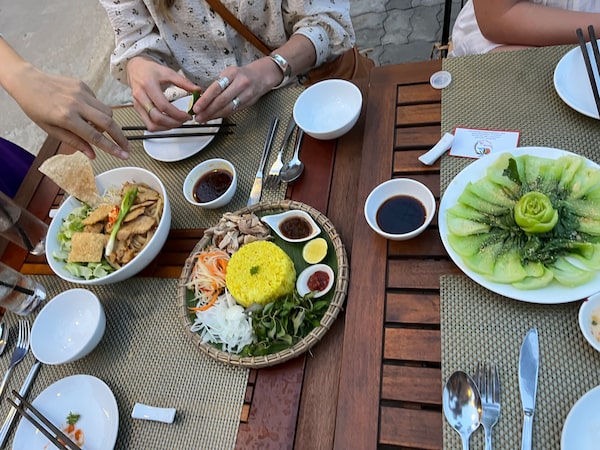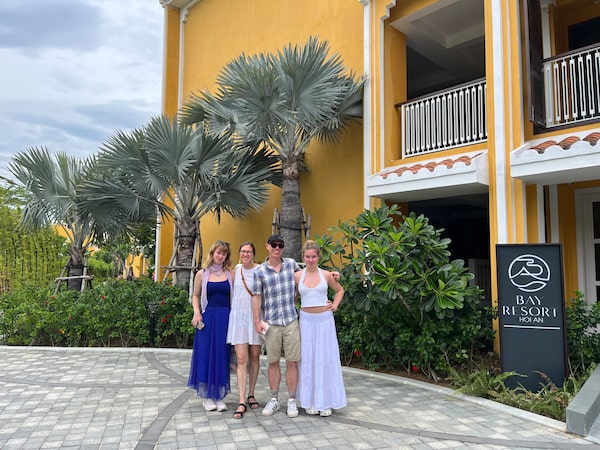While we hope we will always have opportunities to travel with our teenage daughters, we are anxious about the end of their childhood. Avia is now 17 and leaving for university soon. Esmé is a typical 15-year-old and profoundly uninterested in my wife and me. They are already busy with study and ambition, and we are both thrilled and anxious by what comes next.
One way to reduce this panic, for us and for all parents in our predicament, is to book a holiday, drawing the family away from our phones, the dramas of teenage girlhood and middle-aged corporate life.
Four warm-weather escapes for winter
France, our favourite, was too far away from our current home in Tasmania for a 10-day trip. So was our second favourite, the Pacific coast of Mexico. We wanted culture and history, heat, superb food and access to beautiful beaches.
Vietnam wasn’t a difficult choice.
What we learned, in our pretrip research, was that it would be best to pick either the south, the north or the centre of the country for the short duration of our trip. I reached out to a Vietnamese friend for advice, and he suggested the centre as our introduction, if only so we could experience his favourite city in all of Asia – Hoi An.
We arrived in nearby Da Nang, a youthful and fast-growing city famous for its beaches, seafood, surrounding mountains and complex history – it was here that U.S. troops first landed and finally departed during the Vietnam War. Our hotel, the Pullman Da Nang, one of a number of multinationals, is on a relatively quiet part of the spectacularly long beach. It is within walking distance of the action at the nearby An Bang Beach, which is more suited to parties and fishing adventures. The water in front of our hotel was clear and bathwater warm on our first day. On other days the waves were big enough that Esmé and I could surf – her well, me badly.

Riverside dinner at Secret Garden in Hoi An, including local specialties cao lau (left) and banh bao vac (white rose dumplings, right).Todd Babiak/Supplied
We took a day trip from Da Nang up and over a mountain pass to the imperial city of Hue two hours north, and had the good fortune to spend eight hours wandering with our guide, Vo Thi Thanh Thuy, a brilliant and proud Vietnamese university student who told unforgettable stories about the deep ethnic, royal and religious history of the place. We learned about Chinese, French and American eras, and how it feels now to live in a ferociously independent communist state opening up to foreign direct investment.
With Thuy, we ate delicious local specialties such as nem lui, lemongrass pork skewers and a delicate yet complex beef noodle soup called bun bo hue, which was sweet, spicy and sour at once.
Back in Da Nang, we tried variations of banh xeo, a savoury pancake filled with fresh and delicious vegetables and seafood, and mi quang, a compromise between rich turmeric soup and a green salad. On the weekend, we ate near the Dragon Bridge, which is exactly what it sounds like – a bridge shaped like a dragon that breathes fire for the tourists at 9 p.m. We walked through the night market. In our constant search for whatever the locals love, Avia discovered egg soda – and regretted her discovery.

Avia Babiak in a fish market in the An Bang neighbourhood of Da Nang.Todd Babiak/Supplied
Our next stop was to the city my friend had sent us, Hoi An, south of Da Nang. Hoi An is famous throughout Southeast Asia for its impossibly well-preserved and ancient town centre. For centuries it was a port city and a trading centre, with Chinese, Japanese, Indian and European history and influences on food, culture and architecture.
We booked five nights at the Bay Resort Hoi An, across the bridge from the market, and walked incessantly past and through the gorgeous architecture and, at night, an informal festival of coloured lanterns and live music. Our stroll from the hotel to the ancient town was always an olfactory adventure, variations on diesel exhaust, raw fish in 30 C, incense, sewer, barbecued meat, durian and wet cilantro.
Hoi An is a famous textile centre, with hundreds of tailors. Some are modest and others are internationally renowned, such as Yaly Couture and Kimmy Tailor, who has a shop in Toronto. We had done so well with Thuy’s list of favourites we went to the tailor she recommended, Tina Designs, on the outer ring of the ancient town. Esmé got the graduation dress of her dreams and we enjoyed every moment we spent with Tina and her hilarious, charming team of women: Lina, Thinh and Hieu.
When we first arrived, I could have purchased inexpensive SIM cards for our phones but I am so glad I didn’t. Instead of spending our vacation staring at our screens, we talked to each other, about Vietnam but also about school, boyfriends, fashion, our lives as Canadian expatriates, our creative projects, our plans for the future. In the ocean and swimming pool we played the complicated and nonsensical games Avia and Esmé used to invent years ago, such as water panthers and sneaky salmons. Yet soon Avia would be in university in Sydney or Brisbane or Vancouver, and she would go on trips with her wonderful new friends instead of her lame parents and I was hit with quiet melancholy.
We had been learning about Vietnamese Buddhism, which inspired me to stop brooding, to accept and focus on the present: walking down the pretty streets together with TikTok-famous lime and lemongrass iced tea, riding in the lantern boats of Thu Bon River, visiting the city’s little pottery village or eating Hoi An delights. Our favourites were banh vac and banh bao, two kinds of dumplings, and cao lau, another soup and salad hybrid filled with thick Japanese-style noodles you see drying all over the ancient town in the sunshine. We overdid it at Banh Mi Phuong, where Anthony Bourdain correctly said they make “a symphony in a sandwich.”
Avia is encouraging me to imagine more adventures together, despite what is coming. I hope we will be back in Vietnam for trips to the north and the south, for more local history and street food, night markets and the time-stopping hopes of four curious foreigners holding on to each other a bit longer.

Avia Babiak, Gina Loewen, Todd Babiak, and Esmé Babiak at the Bay Resort Hoi An.Todd Babiak/Supplied